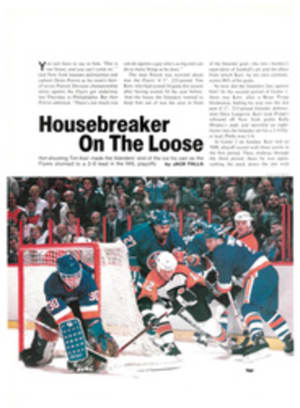
Housebreaker On The Loose
You just have to say to him, 'This is our house, and you can't come in,' " said New York Islander defenseman and captain Denis Potvin as his team's best-of-seven Patrick Division championship series against the Flyers got underway last Thursday in Philadelphia. But then Potvin admitted, "There's not much you can do against a guy who's as big and can do as many things as he does."
The man Potvin was worried about was the Flyers' 6'3", 225-pound Tim Kerr, who had scored 54 goals this season after having scored 54 the year before. And the house the Islanders wanted to keep him out of was the area in front of the Islander goal—the slot—hockey's equivalent of football's pit and the place from which Kerr, by his own estimate, scores 80% of his goals.
So how did the Islanders fare against him? In the second period of Game 1, there was Kerr, after a Brian Propp breakaway, bulling his way into the slot past 6'2", 215-pound Islander defense-man Dave Langevin. Kerr took Propp's rebound off New York goalie Kelly Hrudey's pads and shoveled an eight-footer into the Islander net for a 2-0 Flyer lead. Philly won 3-0.
In Game 2 on Sunday, Kerr tied an NHL playoff record with three assists in the first period. Then, midway through the third period, there he was again, rushing the puck down the slot with 6'1", 200-pound Islander forward Bob Nystrom futilely trying to check him. Kerr's shot from about 10 feet hit Nystrom's skate, and the Islander slipped and crashed into goalie Billy Smith. Nystrom, Smith (who lost his mask in the collision) and the puck all went tumbling into the Islander goal while Kerr, still standing, raised his arms in celebration. It was his seventh goal in the playoffs, and the Flyers, with Propp breaking out of a slump with three goals, won 5-2 to take a 2-0 series lead. Some people had billed the Flyers-Islanders series as a showdown between two of the highest-scoring right wings in the game, Kerr and New York's Mike Bossy, who had 58 goals this season and has averaged 59.25 per season in his eight-year NHL career. But it was strictly no contest. The two-game stats: Kerr, two goals and three assists; Bossy, no goals and no assists.
So what did the Islanders do wrong against Kerr? "You have to get him before he takes his position," Islander left wing Bob Bourne, who frequently found himself playing opposite Kerr in the first two games, said, echoing Potvin. "Make him take a spot he doesn't want to take, because once he has position, he's a strong man and hard to move." Ask Langevin and Nystrom.
The Islanders' hopes of bouncing back against the Flyers as they had against the Washington Capitals in the first round—they became the only team ever to recover from an 0-2 deficit and win a five-game series—may well hinge on their success in stopping Kerr from making their house his home. That's something few teams have been able to do. In the playoff preliminary round Kerr trashed the New York Rangers in one of the greatest individual scoring displays in NHL history. With Philly leading New York two games to none, but trailing 3-2 in the second period of Game 3 at Madison Square Garden, Kerr exploded for four goals in a span of eight minutes and 16 seconds to lead the Flyers to a 6-5 win. Those were the most goals scored by a player in one period in NHL playoff history, and they gave Kerr his fourth four-goal game this season. It was a typical Kerr production: Two of the goals came on shots from inside 10 feet, and on three of the goals Kerr one-timed the puck, i.e., shot off the pass.
"You can practice one-timing, but you can't coach it," says Flyer head coach Mike Keenan, who, to exploit Kerr's strong, quick hands, frequently has him take face-offs.
"His hands are every bit as fast as Mike Bossy's," says Flyer assistant coach Ted Sator. As a case in point, Sator cited Kerr's third goal against the Rangers, on which he backhanded a Peter Zezel pass from the left corner into the New York net while wearing 6'3", 215-pound defenseman Barry Beck.
Such abuse from opposing defense-men neither bothers nor deters Kerr. In the first period of the opener against the Islanders, as Kerr, without the puck, moved into the Islander slot, Potvin stood in his way, a fairly clear-cut but uncalled case of interference, hoping to resist Kerr's advance and turn him to the outside. But Kerr rumbled on, forcing Potvin to give ground grudgingly. "If you have to concede a little, you do," said Potvin.
The Islanders appeared to back off Kerr a bit in Game 2. "They tried playing around me," said Kerr. Explaining the strategy. Islander defenseman Ken Morrow said, "Like we do with [Wayne] Gretzky, we just wanted to deny him the puck." But they didn't deny Kerr's cross-ice pass to Joe Paterson that led to Philly's first goal, his pass across the crease that set up Propp's first goal or his close-in shot that produced a rebound Propp banged in for his second goal. He then scored his own goal and for the night had five shots on Smith. The Islanders could have gone back to trying to push him around, of course, but as Morrow says, "That's like pushing a wall."
Kerr actually seems to welcome the rough stuff. "That's what the pads are for," he says. "I don't snap out much. Sometimes they try to bang me from the back, but that just doesn't work."
"To get Tim out of the slot, you're trying to push 225 pounds," says Flyer defenseman Brad Marsh. By Kerr's own testimony, Boston defenseman Mike O'Connell plays him best. "He stays between me and the puck," says Kerr. "He plays me with his mind." Which, face it, is a lot easier than playing Kerr with your body.
"He's like a tree out there," says Los Angeles coach Pat Quinn, who coached the Flyers during Kerr's first two seasons, when Kerr scored only 22 and 21 goals. "But he's a tree with brains."
Kerr attributes his success as a scorer to his preference for the wrist shot over the slap shot. His wrist shot is, often as not, actually a snap shot on which he draws the stick back just a few inches behind the puck but still uncorks a blast. Kerr's faith in wristers is borne out by the fact that he led the Flyers in shooting percentage for four straight years before finishing second on the team this season—with 20.2%—behind Ilkka Sinisalo. "Of course, it's pretty hard to miss from the crease in," says Kerr, jokingly using a golfing expression to describe his play: "My short game's pretty good."
"But Tim doesn't get goals just by standing in front and mucking it up." says Marsh. "He knows how to move through the slot. He's like a good rebounder in basketball."
Kerr has had to work on his skating, and he thinks his improvement in this area is one of the reasons he has gone from a 20-to a 50-goal scorer. "As a kid in Tecumseh, Ontario," Kerr says, "I grew too fast and didn't have good coordination. When I went to Junior A, I couldn't even turn around and skate backwards." Nor was Kerr any great shakes on the blades when he was signed by the Flyers as a free agent in January 1980. It wasn't until he suffered ligament damage in his right knee and missed 37 games in 1982-83 that he improved. "The rehabilitation work strengthened my legs and improved my agility," says Kerr, who still isn't in the same class as a skater as the Flyers' Sinisalo or Mark Howe but gets where he has to go in plenty of time.
Kerr is one of only five current Flyers with the team the last season it won a playoff game—April 7, 1982—and he savors the responsibility that comes with his emergence as a star. "There's a lot more pressure being a 50-goal scorer than a 20-goal scorer," he says. Still, Kerr sometimes craves more ice time than he gets. Because of a series of shorthanded and four-on-four situations, Kerr was limited to just three shifts in the first period of Game 1, a circumstance that had him grumbling the next day. Yet it is hard to fault Keenan's use of Kerr. He has pretty much broken up Kerr and Propp, the team's second-leading scorer, in order to add more balance to the Philly attack, and it has worked. Keenan frequently puts Kerr on the ice with good young legs like Zezel and Todd Bergen, both of whom have the speed and skill to get the puck to the big man in the slot.
And now, unless Potvin and company can find a way to keep Kerr out of their house, this divisional championship will end with the Flyers in the Stanley Cup semifinals and the Islanders out in the cold.
PHOTO
HEINZ KLUETMEIER
Despite the attention of a host of Islanders, Kerr (12) gave Hrudey fits in the opener.
PHOTO
PAUL BERESWILL
In Game 2 it was goalie Smith's turn to make an attempt—also in vain—to contain Kerr.
PHOTO
HEINZ KLUETMEIER
Just because Kerr embraced the Isles' Bryan Trottier doesn't mean they're friends.
PHOTO
GEORGE TIEDEMANN
A sign New York was through? Philly fans thought so as Propp (26, above) scored a hat trick on Smith (below) in Game 2.
TWO PHOTOS
PAUL BERESWILL
[See caption above.]

